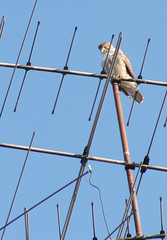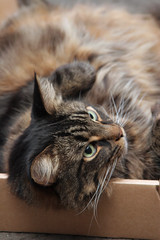Lori & I have been playing MMORPGs -- "Massively Multiplayer Online Role Playing Games" -- for a little over a year now. Maybe we're enjoying them so much because we met in a Dungeons & Dragons group.
We'd avoided the MMORPGs for a long time. Mostly when we played computer games together, it would be locally-networked ones like
Diablo/
Diablo II or
Dungeon Siege. We suspected that MMORPGs would be huge time sinks, and Lori wasn't too keen on being hit on by hordes of 16-year-old gamers (a not uncommon problem in online games).
We eventually gave in when one of Lori's colleagues injured his back and had to spend a couple of months away from work. He got her into
City of Heroes, a super-hero RPG. We played
CoH for few months, including a very fun Halloween weekend last year. It did turn into a time sink, but a managable one (especially over the winter, when Lori doesn't want to go out much anyway), and the 16-year-olds weren't too bad.
City of Heroes is a very well designed and executed game, but a little limited. Missions were of two basic types: "Go to X district and kill N bad guys of type Y" and "Go to X district and clear out a cave/warehouse/office building of bad guys of type Y and their boss". We also found that levelling your character up was very slow once you got past level 15 -- downright tedious when there's just two of you. A lot of
CoH requires teams of at least four. When Lori's colleague maxed out his character at Level 50 -- we were still down around 20 -- he moved on to
Everquest 2 and we followed. There, we teamed up with some friends of Lori's colleague in a guild, and played together for a few months, but eventually had to leave the game because one of the guild members started making life miserable for everyone.
So we moved to
World of Warcraft. So far, this has been my favourite of the games. The game mechanics are simpler than
EQ2's (especially in crafting -- making things out of material found in the game), but the game is more involving than
CoH. It looks better, to my mind, as well.
WoW has been criticized for the simple, cartoony character designs --
EQ2's designs are much more realistic looking -- but the animation is much better in
WoW, and I think that makes all the difference. A photo-realistic rendering that moves like Mr. Roboto just isn't as convincing as a cartoon that moves naturally.
Lori & I have just passed Level 40 in
WoW, the highest we've ever gotten any of our MMORPG characters (2/3 of the way to the limit), and we're still enjoying the game a lot, but we may be slowing down there soon because
City of Villains is coming out next week.
While I was griping about
CoH above, we did enjoy the game a lot, and probably would have enjoyed it more had we had a team to play with. (We both prefer playing with people we've known for a while, rather than any random player who happens by when we need a team.) Now that we have an established circle of gaming friends, we're thinking
CoV could make the comic book adventures interesting again.
One of our
WoW guildmates got us in on the beta, which finishes tomorrow, and we've had a fun couple of days playing around with it. One of the things that made
CoH famous was its character design system -- it's so good at making superheroes that Marvel Comics sued over people making up heroes that look like Marvel characters. The
CoV system adds a whole bunch of new elements, to the point that I was able to create the ultimate in web cliche super villainy: a Robot Ninja Pirate Zombie! Unfortunately, I couldn't work monkeys into him, but still, that's not bad!
So far the game is a lot like
CoH. The original superheroes were divided into "Archtypes" (character classes), with each Archetype having a choice of Primary and Secondary powers suitable to that type. For example, "Scrappers" (think Wolverine or Batman) had things like "Claws" or "Martial Arts" for primaries and "Super Reflexes" or "Regeneration" as secondaries. Once players had gotten comfortable in the game, the various flavours of hero became known by the mix of powers they had: A Wolverine-like hero would be a Claw/Regen Scrapper; Superman would be an Invulnerability/Super Strength Tanker (tankers stand their ground and hold the bad guys' attention while the more fragile heroes take them out).
City of Villains stirs things up a bit by mixing and matching the sets available. The
CoV "Brute" has access to primary sets similar to the
CoH Tanker, but the secondary set choices are more like the
CoH Scrappers.
For now, I'm mainly interested in the Mastermind, which lets you summon minions to do your fighting for you. My favourite so far are the robot drones, which drop out of the sky in steel packing crates when you call for them. Other choices include mercenaries, ninjas, and zombies.
Tomorrow is the big beta finale. With
City of Heroes, they finished the beta with an alien invasion which set up several of the story lines for the released game. With
CoV, the invasion will be by the (non-player) superheroes from
CoH. I'm looking forward to watching the chaos unfold.
Read more!
 All of this is completely irrelevant to Toronto hawks, except to explain why I'm not posting about them and not books. The hawks -- well, one hawk -- came in this afternoon on our way back from groceries. We noticed a couple of flocks of synchronized pigeons circling over the street. We found that a little odd, as Toronto pigeons are not known for exerting themselves, until we noticed why they were flapping around: they were chasing a hawk, who fled the pigeon-infested area and settled down on a TV aerial on a nearby building.
All of this is completely irrelevant to Toronto hawks, except to explain why I'm not posting about them and not books. The hawks -- well, one hawk -- came in this afternoon on our way back from groceries. We noticed a couple of flocks of synchronized pigeons circling over the street. We found that a little odd, as Toronto pigeons are not known for exerting themselves, until we noticed why they were flapping around: they were chasing a hawk, who fled the pigeon-infested area and settled down on a TV aerial on a nearby building.


 I'm not planning on seeing Chicken Little, but then I haven't seen any Disney animated film since
I'm not planning on seeing Chicken Little, but then I haven't seen any Disney animated film since